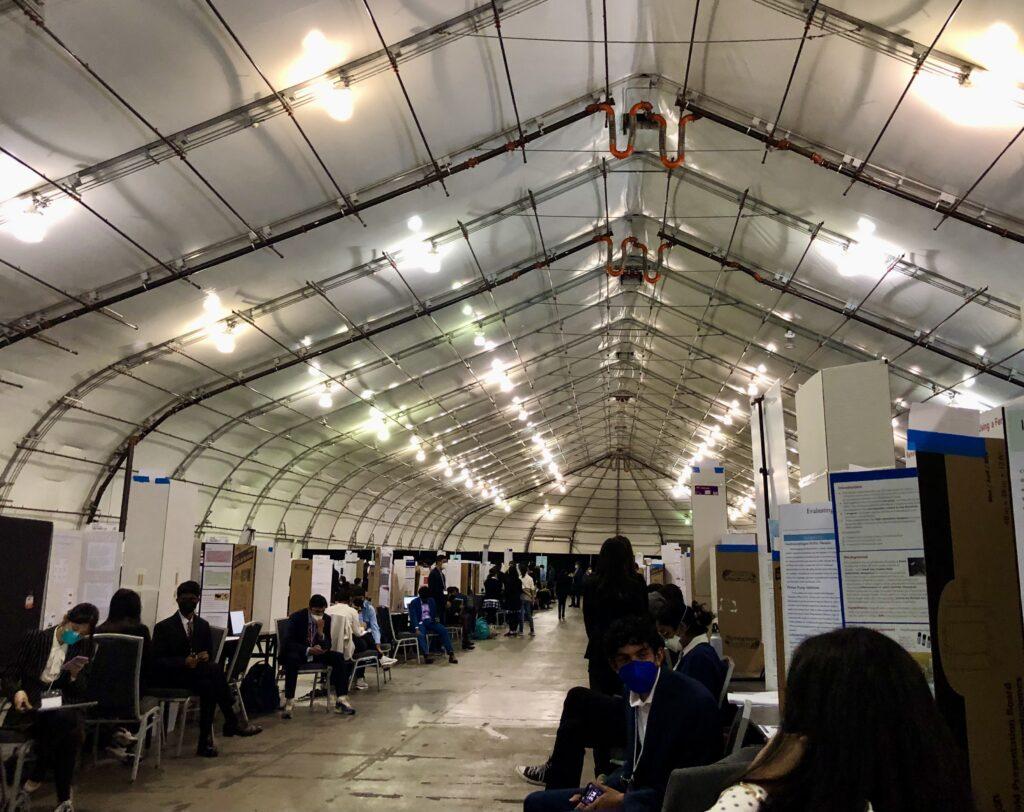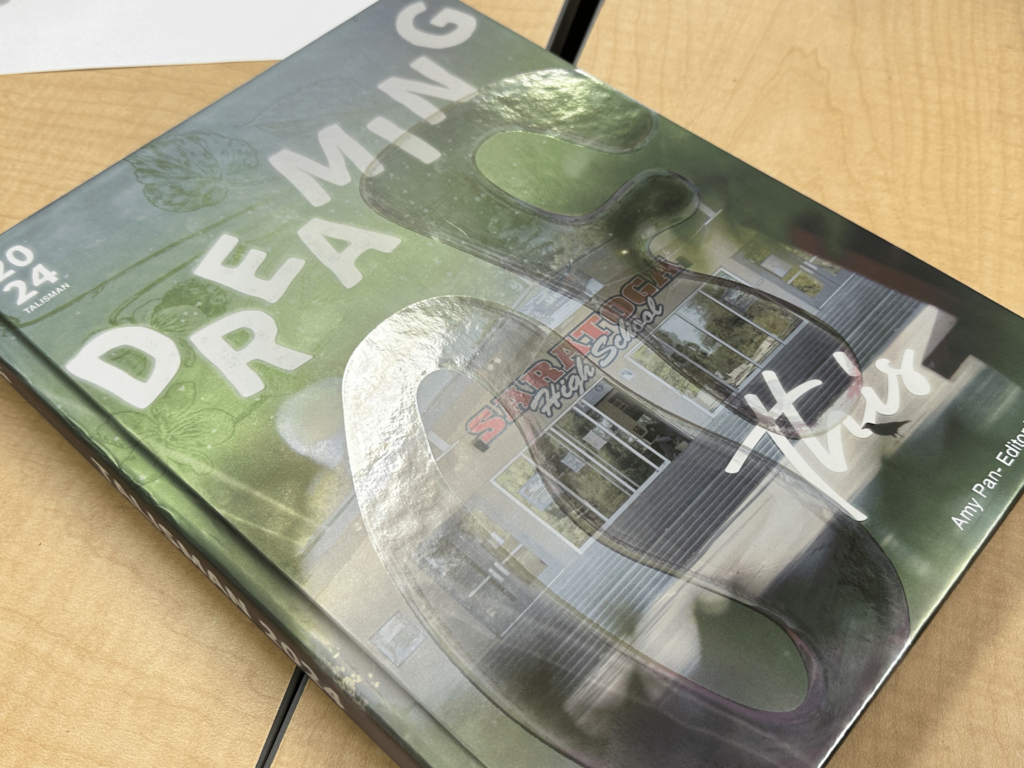Within the large blue dome tent at San Jose’s South Hall, hundreds of students around the Bay gathered to present their projects for the Synopsys Science Fair. Four-feet tall posters stretched along the hall’s perimeter, each placed next to each other with less than a foot between them. For the first time since the pandemic forced judging to move online in 2020, the fair was held in person on March 9 and boasted over 850 participants.
According to the list of winners posted on the Synopsys Championship website on March 26, 11 out of 18 Saratoga participants won an award (full list included below).
Additionally, four Saratoga students — juniors Lynn Dai, Sanjoli Gupta and Zeyneb Kaya and senior Nidhi Mathihalli — qualified for the California State Science Fair (CSEF) on March 20.
Broken up into two age categories, the middle-school and high-school divisions, the fair handed out various category and sponsored awards from different companies who provided judges for the event. High school projects were further distinguished and judged separately between Regulated Research Institutional (RRI) — ones that had been conducted with professional research scientists at a company or lab — and non-RRI projects — ones conducted by students independently. The grand prize projects at Synopsys will later participate in the CSEF on April 11 and possibly advance to Regeneron’s International Science and Engineering Fair in mid-May.
The judging capped off an arduous, 6-month process that students started in October, from the admission of a project proposal in November to the upload of an abstract in late February.
Unlike previous years when the fair was held in person, there was no public viewing, which usually allows parents and other community members to come in near the end of judging to observe and engage with students and their posters.
Even so, many participants enjoyed the flexibility of the event: Throughout the judging window, students were allowed to freely connect with others to discuss projects in different fields, ranging from software engineering, chemistry, environmental science and astronomy in the physical sciences department to biomedical and computational engineering in the biological sciences department.
Students also enjoyed receiving feedback from judges and learned various ways to expand on their project or product.
Most of the 18 SHS students’ projects — four of which were biology related and the other 14 of which were physical science — registered their project under a science teacher, including AP Biology teacher Cheryl Lenz, AP Chemistry teacher Janny Cahatol and AP Physics teacher Matthew Welander. Four other students created their project and registered under Cathy Messenger, who teaches the Advanced Science Research course with Jennifer Lee at Los Gatos. Here is a more in-depth look into some of the participants from Saratoga this year:
Kyleen Liao: Software and Environmental Engineering
Junior Kyleen Liao, inspired by the isolating effect of the various lockdowns and wildfires during COVID-19, created a project using graph neural networks to forecast air quality in California.
“During the pandemic, I relied on walks around my neighborhood to relax and get away from the seemingly endless Zoom calls,” Liao said. “However, when the wildfire season hit, I could no longer enjoy my favorite outdoor activities due to the dangerous air quality.”
In her project, Liao researched wildfire-influenced pollution and aimed to find solutions to help people stay healthy. Her project works similar to weather reports — as weather forecasts are used to maximize comfort and safety, Liao’s neural networks can be used to plan around accurate air quality predictions.
As a second-year participant, Liao said she enjoyed the in-person setting of the fair more. Last year, she said she had no opportunities to interact with peers on Zoom, as all participants presented their projects in an isolated room for 10 minutes in front of their judging panel. This year, the fair gave participants more than three hours to walk around and see other students’ projects.
“Though some might argue that it’s much more inefficient, I find the in-person experience to be much more engaging and educational,” Liao said.
Shayda Oliaei: Computational Biology
Junior Shayda Oliaei conducted a statistical analysis on conditions favoring the selection of cancerous cells using MATLAB, a programming platform that allows for the creation of user interfaces like apps.
She studied a specific gene — the p53 gene — that commonly codes for cancer in mammals. While elephants, who have 20 sets of this gene, don’t get cancer often, she said that humans only have one and develop cancer at a higher rate. Her project investigates the correlation between these two factors.
Oliaei compiled data from p53 mutations to determine associations between p53 and other genes across different cancer types. Using this data, she created three pages of an application using MATLAB: The first plots the frequency of mutations in different cancer types and tumor-infiltrated cells; the second models gene expression to determine if a higher or lower risk of mutation is present in the expression of certain genes; and the third combined graphs from the first two pages to find the genes most relevant to a specific type of cancer.
“I really enjoyed exploring the background research of my project,” Oliaei said. “It felt like I was creating an experiment that involved higher-level concepts than what I learned in AP Biology.”
While she didn’t expect so many projects in the fair, Oliaei said she enjoyed hanging out with new people and gained a lot of inspiration for future projects.
Additionally, she enjoyed presenting and explaining her work, an experience that she said helped her determine the strongest points of her project.
“My last judge was involved in pharmacology, and she offered a really interesting perspective that I never considered before,” Oliaei said.
Even though Oliaei started mapping her project idea in late October and looked at different databases in December, she said she still found that the project was rushed in the second semester. Every week starting from January to the fair judging day in March, Oliaei worked three to four hours debugging her code.
“I would definitely recommend other participants to start earlier — it can get extremely chaotic as most start creating their actual project in January, and you’re likely going to need a lot of help,” she said.
Tarun Ramakrishnan: Physical Engineering for Chemistry
Sophomore Tarun Ramakrishnan’s project was inspired by his experiences as a waterpolo player. After learning that the constant splashing of chlorinated pool water damaged the tear film of players’ eyes, he pursued a project that was aimed at creating a cleaning chemical that could replace chlorine without damaging the eyes.
“This was my first time doing Synopsys, and it seemed like a really good avenue for me to pursue my interest in science,” Ramakrishnan said.
Ramakrishnan did the project solo in four months, with only some planning guidance from chemistry teacher Kathy Nakamatsu. He created an aquarium in his home and conducted various pH tests with a variety of chemicals to find the most effective one. In the first few iterations of his project, Ramakrishnan found that his results were often random, though he still finds the hypothesis the most challenging portion of the process.
“Coming up with a hypothesis is challenging because of the disjointed nature of my results,” he said. “Trying to compile them all to make a central claim took many tries.”
At the fair, Ramakrishnan enjoyed the opportunity to present his project to the judge panel and answer their questions. At next year’s fair, he hopes to explore Artificial Intelligence.
“It was an amazing experience overall,” Ramakrishnan said. “I’m really excited to do it again next year and interact with a lot of interesting students once again.”
The following students won awards at the fair:
Freshmen:
Arahan Balasubramanian, “A Novel Multi-Layered Realtime Approach to Ensure Distracted Young Driver’s Safety using Deep Learning and Geolocation” (Honorable Mention, Physical Science and Engineering)
Yash Sharma, “A Novel Drought Forecasting System Using Deep Learning Techniques” (Sponsored Award, Physical Science and Engineering)
Nolan Woo, “Absolute Pitch: Recognizing Live Music to Automatically Scroll Through Sheet Music” (2nd Award, Physical Science and Engineering)
Juniors:
Lynn Dai, “Reduced Psoriasis Skin Irritation Symptoms through the Effects of Chinese Herbal Medicines on Planarial Stem Cells” (1st Award, Biological Science and Engineering)
Sanjoli Gupta, “Changing Climate Will Cause Internal Climate Migration in Brazil, Pakistan and Somalia” (1st Award, Physical Science and Engineering)
Zeyneb Kaya, “MADLIBS: A Novel Multilingual Data Augmentation Approach for Low-Resource Neural Machine Translation” (1st Award, Physical Science and Engineering)
Kyleen Liao, “Forecasting Air Quality in California By Modeling the Effects of Meteorology and Wildfires Using Graph Neural Networks” (2nd Award, RRI Physical Science and Engineering)
Seniors:
Lisa Fung, “Developing a Coupled Matrix-Tensor Factorization Model in Python to Analyze Mobility Data for Disaster Response” (Honorable Mention, RRI Physical Science and Engineering)
Jeremy Lu, “A Novel Approach to Optimize Memory Reconstruction Using Joint Multimodal Networks” (Honorable Mention, Physical Science and Engineering)
Nidhi Mathihalli, “Using Comp Eng and AI/ML to Create a Currency Detection Device for the Visually Impaired in Third World Countries” (1st Award and Sponsored Awards, Physical Science and Engineering)
Howard Shu, “Investigating how polymer doping for the electron transport layer affects efficiency in tin-based perovskite solar cells” (Honorable Mention and Sponsored Awards, Physical Science and Engineering)



























